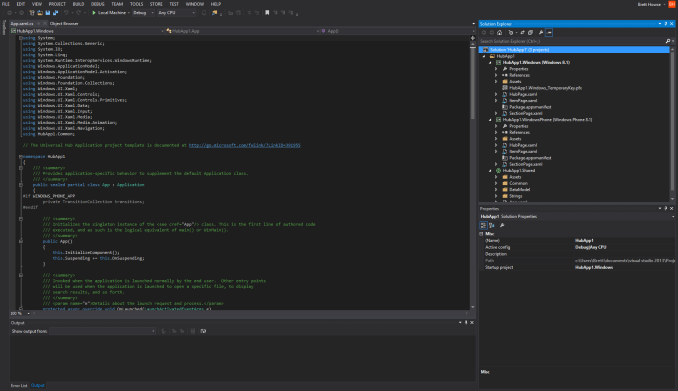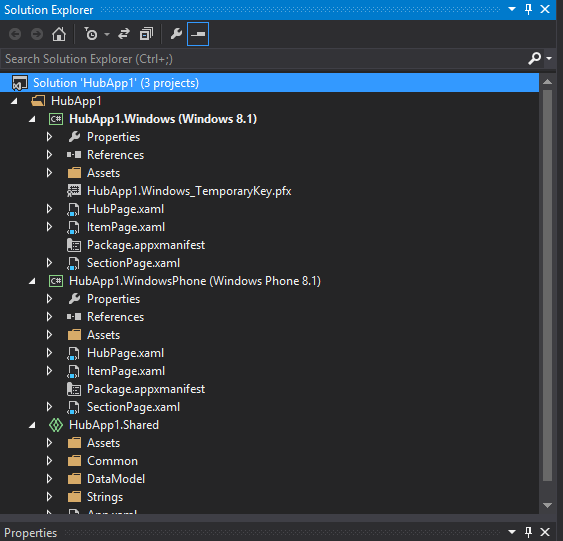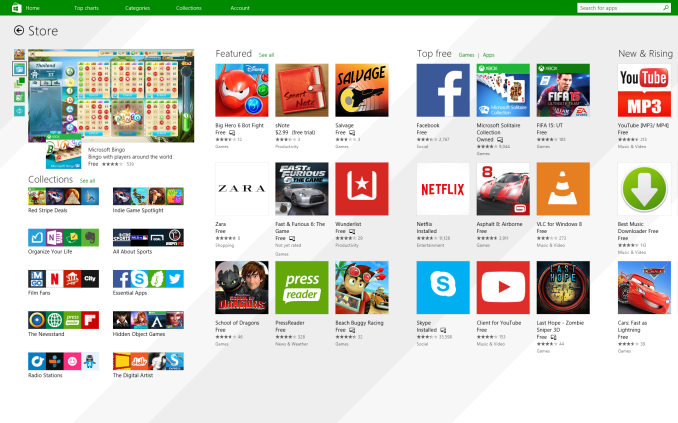Windows 10 Technical Preview First Impressions: The Return Of The Desktop
by Brett Howse on November 13, 2014 8:00 AM EST- Posted in
- Software
- Microsoft
- Windows 10
Universal Apps and the Windows Store
We just got done discussing why a single user interface for the OS across multiple devices is not always the ideal solution, so of course the obvious question with Universal Apps is why would you want it with the app model instead? Thankfully this is not the case although the term Universal App might lead people to believe they are attempting to have a single app target all of their platforms. The truth of the matter is that Universal Apps are Universal in the sense that they share a common app store.
If Microsoft is going to have Windows 10 succeed on desktops, laptops, tablets, phones, and even Xbox One, they need developer buy-in. A platform without apps is not much use to anyone. With the Universal App, they can bridge all of their platforms with a single App in the store. Under the hood, each app is created with a common framework of code, as well as multiple user interfaces in order to tailor the experience to the correct device type. Below is a screenshot of Visual Studio – Microsoft’s developer tools – with a new Universal App about to be created.
 Visual Studio Showing a Universal App Project
Visual Studio Showing a Universal App Project
As you can see, there is a shared portion of code, and then a project for the UI for Windows 8.1, and Windows Phone 8.1. Xbox One is not available yet, but should be added in a future release of Visual Studio.
A close up of the projects
But you may be wondering why any of this is necessary. Windows has the largest selection of applications of any system ever. That is of course true, and the Win32 framework has served both Windows and its users well over the years. But with the new WinRT framework there are some big advantages. First, it can be written to in multiple languages including HTML. WinRT supports C++/CX, C#, VB.NET, and HTML scripting with JavaScript and TypeScript. The security model for WinRT apps is a lot different than Win32, with all WinRT apps running in a sandbox mode for higher security. Unlike apps written in .NET, WinRT is native code, which should result in better performance. Contracts and Extensions are also new to WinRT, and allow apps to share data while still being in a sandbox. One of the biggest advantages of WinRT is that it is DPI aware, and can automatically scale apps appropriately based on screen size and screen resolution. Here, as we know, Win32 apps can struggle even though there are solutions in place.
Adobe Touch WinRT (left) vs Adobe Reader Win32 (right) on HiDPI display
One of the biggest disadvantages of WinRT is that it is only available on Windows 8 and newer devices. With Windows 8 struggling in the market as compared to Windows 7, the user reach of a developer targeting WinRT apps in the Windows Store would be for a subset of the total user base. With Windows 7 having over 50% of the desktop OS market share to itself, this is going to be an issue.
With Windows 10, Microsoft is certainly targeting Windows 7 users. If they can convince them to upgrade to the latest version of the operating system, then the new environment will have a much larger target base and will hopefully encourage developers to target the Windows Store. We have not heard of any upgrade promotions or pricing yet, but this is one of the biggest advantages Apple has had over the years. Their user base generally upgrades the OS at a much faster uptake than Windows. This allows developers to utilize newer APIs in the latest versions of their operating systems and keep the platform progressing. Microsoft has already had to deal with people being stuck on Windows XP, and they must be wanting to avoid that with Windows 7.
Since we are discussing Universal Apps and their advantages, one of the biggest advantages is the Windows Store. With Microsoft hosting the entire download and purchase of all WinRT apps, having user settings and apps sync from one device to another is much easier. One of the greatest experiences with Windows 8.1 is signing into a new PC for the first time. When you log in with your Microsoft Account, the system asks you if you would like to copy the devices and apps from one of your other devices, or if you want to start with a clean machine. If you choose a previous machine, all of the settings, wallpaper, Start Screen layout, and Windows Store apps are synced to the new device. In the case of Windows Store apps, the app itself is listed on your Start Screen, but it is not downloaded until the first time you select it. This avoids a situation where you will significantly delay the initial login time with a massive download, as well as avoid filling the available storage with apps you may not need on that particular device.
Also, like modern tablet and smartphone OSes, WinRT apps from the store are automatically kept up to date by the store. This avoids a lot of the issues with viruses and malware attacking an older version of a product since in theory it will not be around any longer.
The one thing missing from this are the older Win32 apps on the desktop, because they are not available in the Windows Store. Prior to Windows 10, desktop apps could be listed in the store, but the store would then link to the developer’s website to allow you to purchase and install the app. With Windows 10, rumors are that desktop apps will also be available and managed through the Windows Store. Assuming this does happen, then this will be a major boon to users. Desktop apps should in theory also be able to be kept up to date using the Windows Store which should cut back on the number of outdated pieces of software targeted by malware.
The Windows Store is a key piece of Windows 10. Universal Apps can be made available for multiple platforms through the store, and, if the rumors are true, even desktop apps will be available through the store. This should make the Out Of Box Experience (OOBE) very good for users with a Microsoft Account. The WinRT framework has not yet had the killer app written for it, so hopefully with Windows 10 the framework will be expanded to allow for more powerful apps to be created.













198 Comments
View All Comments
SlyNine - Monday, November 24, 2014 - link
You act like their not allowed to disagree. They were not talking about you.why you choose to feel butt hurt is a mystery.In my case it's exactly right. it was an interface I had no desire to learn when it offered no real advantages.
Whiznot - Saturday, November 15, 2014 - link
Microsoft is losing me by including the useless store and by removing Windows Media Center. WMC is the only reason I'm not running Linux on my HTPC.Zingam - Saturday, November 15, 2014 - link
"Microsoft has already had to deal with people being stuck on Windows XP, and they must be wanting to avoid that with Windows 7."Hahaha, Microsoft, maybe you won't price it in $$$ range then!!! Windows costs more than many people would pay for hardware. :)
Zingam - Saturday, November 15, 2014 - link
So they seem to have finally removed that useless border around the windows!!! That's something I like!!!Zingam - Saturday, November 15, 2014 - link
I also like the gesture features with Windows 8. Dropping would be a wrong step but they do need a tweaking and an improvement, so that they feel confortable with the mouse!SinceWin3.1 - Saturday, November 15, 2014 - link
using 8.1 on newly built desktop. no problems at all. due to a botched office install i had to put new operating system on my laptop. choice: 8.1. problems galore! wifi issues, which now seem to work after connecting multiple times to hot spots i usually use. install borked the first time and now updates won't update. win7 on the 2 year old laptop never had a single issue. i think the problem for MS is that Win 10 seems destined for power users in general. i really think there should be a WinLite 10 that works and doesn't have so many features that ultimately compromise the system and hardly anyone will use. i've even had horrid install issues with office on two computers in the last month. can't anything work anymore???Zingam - Sunday, November 16, 2014 - link
An advice from another User of Windows since 3.1 :DLaptops should never be upgraded to a newer OS. Just use the one that came was pre-installed on it, the one that they were certified for. Since I use laptops exclusively for 10 years now (I haven't bought/built a desktop since 2000), I can't even use Linux, because of that. Once I installed XP on a laptop from CD that I used to intall Windows on other PCs but I got all kinds of problems on the laptop. Then I reinstalled using the installation disk that came with the laptop - no problems at all.
SinceWin3.1 - Sunday, November 16, 2014 - link
I believe you're right! My first choice was to use the restore disks, but they wouldn't work. the error I received was that the disks were not made for this computer. I think this is due to switching out the hdd for an ssd. also, when I cloned the hdd to the ssd, I lost the recovery partition. I needed to use the computer the next day, hence the win 8.1 upgrade. If problems persist, I will get the win 7 restore disks from Asus! First laptop. Live and learn! lolvalnar - Monday, November 17, 2014 - link
I've had no problems doing this, so long as it's just one OS newer. I've put Win7 on Vista Thinkpads without an issue. Lenovo supplies all the drivers. Sure, it may take a few hours/days to get it all, but I've never had an issue.MushroomBomb - Saturday, November 15, 2014 - link
"Return of the desktop..."I've used Windows 8 and 8.1 pretty much since release and have had the desktop and haven't spent a single second in the "Metro UI". Picked it up for $25 on sale.